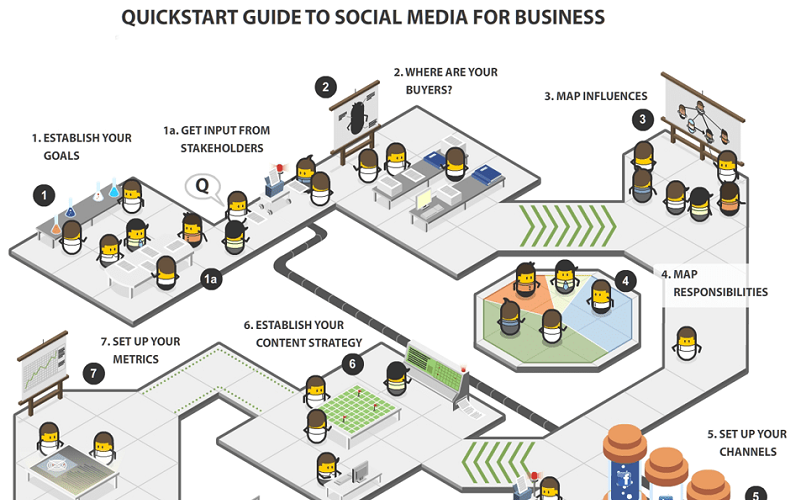
quickstart info
If your business isn’t involved in social media, it certainly should be. It’s a confusing, broad topic, so it’s best for a business to get a good overview of the social media landscape before jumping in. This infographic provides just that.

1. ESTABLISH YOUR GOALS
Ask why you need to be in social media.
Formulate your social media goals and objectives.
Align with the business goals of your company.
1a. GET INPUT FROM STAKEHOLDERS
Conduct interviews and internal surveys to find out what social media channels would best serve your company and your goals.
2. WHERE ARE YOUR BUYERS?
Map your buyers’ personae.
Find channels where your team’s and buyers’ interactions intersect.
Determine which social media channels will work best in reaching out to them.
3. MAP INFLUENCES
Use monitoring tools to find out more about your prospects.
Discover the “influencers” of buyers’ purchase decisions – bloggers, partners, and even competitors.
4. MAP RESPONSIBILITIES
Distribute key roles among stakeholders.
Set up a social media “task force” around key responsibilities
5. SET UP YOUR CHANNELS
Use the internal survey results and buyers’ personae to determine which channels you will engage in, e.g., Facebook, Twitter, LinkedIn
6. ESTABLISH YOUR CONTENT STRATEGY
Source for existing content and repurpose it, e.g., whitepapers, case studies, opinion pieces, videos, etc.
Identify topics that align with key marketing focus areas.
Research to determine relevancy by searching for brand name, competitors, and target keywords
7. ESTABLISH YOUR METRICS
Create and align metrics and monitoring framework with strategic objectives.
Some key measurement goals include Reach, Buzz, Sentiment, Influence.
Measure only what matters to the business.
8. CUSTOMIZE YOUR CHANNELS
Set up, customize and optimize your channels, e.g., multi-author blogging platform, customized FB page, YouTube channel, etc.
9. SET UP ENGAGEMENT FRAMEWORK
Work out who responds, how, where (what channel), and how often.
Constancy and immediacy are keys to well-managed social media engagement.
10. DEVELOP A SOCIAL MEDIA POLICY
Based on best practices, what’s acceptable, out-of-bounds markers, confidential information, business vs. personal capacity, etc.
Document everything to avoid grey areas that may hinder engagement.
11. PUBLISH YOUR INITIAL CONTENT
Develop an editorial schedule.
Populate your channels with appropriate content.
Establish content syndication mechanisms across social media channels.
12. MONITOR & MEASURE
Set up monitoring and measurement tools based on the metrics established earlier.
13. HARNESS THE POWER OF YOUR INTERNAL NETWORKS
Time to get your team to provide the initial ballast.
Propagate, publicize, promote.
14. YOU ARE OFF!
Analyze, Adapt and Improve: Adapt any new findings into current processes, and improve efforts as you navigate through this social media journey.
Remember – this is an iterative process.
